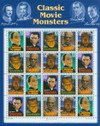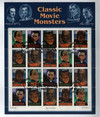
# 3168-72 - 1997 32c Classic Movie Monsters
US #3168-72
1997 Classic Movie Monsters
- Commemorate “Classic Movie Monsters” of Universal Studios and the four well-known actors who brought them to life
- Part of USPS efforts to get young people interested in stamp collecting
- Issued at the beginning of Stamp Collecting Month
- Include scrambled indicia
Stamp Category: Commemorative
Value: 32¢, First Class Mail Rate
First Day of Issue: September 30, 1997
First Day City: Universal City, California
Quantity Issued: 145,000,000
Printed by: Printed for Stamp Venturers by J.W. Fergusson & Sons of Richmond Virginia with Scrambled Indicia by Graphic Security Systems Corporation of Lake Worth, Florida
Printing Method: Photogravure, Scrambled Indicia
Format: Panes of 20 (Vertical 5 across, 4 down)
Perforations: 10.2 x 10.1
Tagging: Overall tagging that stops short of each margin, leaving 14 outside stamps partly untagged
Why the stamp was issued: To kick off Stamp Collecting Month and honor “Classic Movie Monsters” from Universal Studios films and the actors who played them. Part of USPS efforts to attract young people to stamp collecting.
About the stamp design: Picture portraits by artist Thomas Blackshear (previous stamp artist for the 1990 Classic Films, 1993 Joe Louis, and 1995 Jazz Musicians stamps). Blackshear later said creating the stamp art was a “treat” because “monsters have always been a passion with me. I used to collect Famous Monsters of Filmland when I was a kid… Also, I had almost every monster model kit that was ever put out.”
The names of the actors are printed in small white dropout type with the characters’ names in large, brightly colored lettering suggestive of classic movie posters.
Special design details: On the pane of 20, there are photographs of the actors on either side of the “Classic Movie Monsters” inscription along with each actor’s signature.
Scrambled indicia: Each stamp includes hidden images that can only be viewed with a special stamp decoder. This scrambled indicia was a new tactic used by the USPS beginning with the 1997 US Air Force stamp to attempt to combat counterfeiting. Here are the hidden images that can be seen on each stamp:
Phantom of the Opera – Floating masks
Dracula – Bats
Frankenstein – Bolts of electricity
Mummy – Ancient Egyptian gods/goddesses
Wolf Man – Howling wolves
First Day City: The First Day of Issue Ceremony for these stamps was held at Universal Studios, Hollywood, in California.
History the stamp represents: In 1925, American movie-going audiences experienced one of the most horrifying silent films ever created, The Phantom of the Opera. This story of a demented, disfigured organist, who lives in the maze-like tunnels and cellars under the Paris Opera House, was based on a novel by Gaston Leroux.
Wearing a mask, the Phantom wreaks havoc on the opera, strangling a stagehand who has seen him, and sending the theater’s giant chandelier crashing into the audience during a performance. Later, he kidnaps a young singer, Christine, with whom he is enamored, and takes her into his subterranean “home.” Before she is rescued, Christine pulls off the Phantom’s mask to reveal a hideous, skull-like face. The Phantom meets his end at the hands of an angry mob, which beats him to death and throws his body in the river Seine.
The man responsible for bringing the Phantom to life was silent actor Lon Chaney. Born to deaf-mute parents, Chaney was a master of pantomime. As the Phantom, he gave his greatest performance, eliciting feelings of both terror and pity. Chaney also starred in The Hunchback of Notre Dame (1923), London After Midnight (1927), Tell It to the Marines (1927), While the City Sleeps (1928), and Thunder (1929).
US #3168-72
1997 Classic Movie Monsters
- Commemorate “Classic Movie Monsters” of Universal Studios and the four well-known actors who brought them to life
- Part of USPS efforts to get young people interested in stamp collecting
- Issued at the beginning of Stamp Collecting Month
- Include scrambled indicia
Stamp Category: Commemorative
Value: 32¢, First Class Mail Rate
First Day of Issue: September 30, 1997
First Day City: Universal City, California
Quantity Issued: 145,000,000
Printed by: Printed for Stamp Venturers by J.W. Fergusson & Sons of Richmond Virginia with Scrambled Indicia by Graphic Security Systems Corporation of Lake Worth, Florida
Printing Method: Photogravure, Scrambled Indicia
Format: Panes of 20 (Vertical 5 across, 4 down)
Perforations: 10.2 x 10.1
Tagging: Overall tagging that stops short of each margin, leaving 14 outside stamps partly untagged
Why the stamp was issued: To kick off Stamp Collecting Month and honor “Classic Movie Monsters” from Universal Studios films and the actors who played them. Part of USPS efforts to attract young people to stamp collecting.
About the stamp design: Picture portraits by artist Thomas Blackshear (previous stamp artist for the 1990 Classic Films, 1993 Joe Louis, and 1995 Jazz Musicians stamps). Blackshear later said creating the stamp art was a “treat” because “monsters have always been a passion with me. I used to collect Famous Monsters of Filmland when I was a kid… Also, I had almost every monster model kit that was ever put out.”
The names of the actors are printed in small white dropout type with the characters’ names in large, brightly colored lettering suggestive of classic movie posters.
Special design details: On the pane of 20, there are photographs of the actors on either side of the “Classic Movie Monsters” inscription along with each actor’s signature.
Scrambled indicia: Each stamp includes hidden images that can only be viewed with a special stamp decoder. This scrambled indicia was a new tactic used by the USPS beginning with the 1997 US Air Force stamp to attempt to combat counterfeiting. Here are the hidden images that can be seen on each stamp:
Phantom of the Opera – Floating masks
Dracula – Bats
Frankenstein – Bolts of electricity
Mummy – Ancient Egyptian gods/goddesses
Wolf Man – Howling wolves
First Day City: The First Day of Issue Ceremony for these stamps was held at Universal Studios, Hollywood, in California.
History the stamp represents: In 1925, American movie-going audiences experienced one of the most horrifying silent films ever created, The Phantom of the Opera. This story of a demented, disfigured organist, who lives in the maze-like tunnels and cellars under the Paris Opera House, was based on a novel by Gaston Leroux.
Wearing a mask, the Phantom wreaks havoc on the opera, strangling a stagehand who has seen him, and sending the theater’s giant chandelier crashing into the audience during a performance. Later, he kidnaps a young singer, Christine, with whom he is enamored, and takes her into his subterranean “home.” Before she is rescued, Christine pulls off the Phantom’s mask to reveal a hideous, skull-like face. The Phantom meets his end at the hands of an angry mob, which beats him to death and throws his body in the river Seine.
The man responsible for bringing the Phantom to life was silent actor Lon Chaney. Born to deaf-mute parents, Chaney was a master of pantomime. As the Phantom, he gave his greatest performance, eliciting feelings of both terror and pity. Chaney also starred in The Hunchback of Notre Dame (1923), London After Midnight (1927), Tell It to the Marines (1927), While the City Sleeps (1928), and Thunder (1929).


















